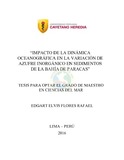Por favor, use este identificador para citar o enlazar este ítem:
https://hdl.handle.net/20.500.12958/3063Registro completo de metadatos
| Campo DC | Valor | Lengua/Idioma |
|---|---|---|
| dc.contributor.advisor | Graco, Michelle | - |
| dc.contributor.author | Flores Rafael, Edgart Elvis | - |
| dc.date.accessioned | 2016-12-30T16:47:12Z | - |
| dc.date.available | 2016-12-30T16:47:12Z | - |
| dc.date.issued | 2016 | - |
| dc.identifier.uri | https://hdl.handle.net/20.500.12958/3063 | - |
| dc.description | Tesis (Maestro en Ciencias del Mar).- Universidad Peruana Cayetano Heredia. | es_ES |
| dc.description.abstract | Las condiciones oceanográficas y geoquímicas asociadas al azufre inorgánico fueron estudiadas en la bahía de Paracas para determinar su impacto en los procesos de sulfato-reducción, el intercambio de sulfuro de hidrógeno en la interfaz agua-sedimento y su movilización hacia la fracción precipitada. Se establecieron tres estaciones de muestreo al interior de la bahía entre abril y junio de 2015. La variación espacio-temporal de las especies de azufre inorgánico disuelto (H2S y SO4-2) y precipitado (Acid Volatile Sulfide AVS y Chromium-Reducible Sulfur CRS) se analizaron en relación a los factores ambientales: velocidad de vientos, oxígeno disuelto, temperatura, pH e indicadores de materia orgánica fresca (Cl-a) y de preservación de materia orgánica (COT y NT), así como azufre total (ST). A partir de los análisis de correlación cruzada, se infiere que en las estaciones más profundas hay una mayor correlación entre el oxígeno disuelto y la temperatura que en la estación somera, la correlación de estas variables con la velocidad de viento no fue significativa (p>0.05). Las aguas de fondo en la bahía muestran alternancia entre condiciones hipóxicas (<1,43 mL/L) y micróxicas (<0.10 mL/L) durante otoño con períodos prolongados y con máximas concentraciones de H2S (4,966.76 uM) en los primeros 20 cm del sedimento. El análisis de componentes principales sugiere condiciones más favorables para la sulfato reducción en abril y una mayor oxigenación en junio, a pesar de esto hay una tendencia de incremento de AVS y CRS hacia junio, posiblemente como una respuesta en desfase de las condiciones iniciales, ocasionando una mayor precipitación de monosulfuros de hierro y pirita hacia junio. A pesar de esta precipitación significativa de azufreexisten importantes flujos difusivos de H2S (en promedio de 574.76 μmol.m².d-1), colocando a la bahía de Paracas bajo un escenario de fuente de H2S, que podría alcanzar una condición más severa (2824.94 μmol.m².d-1) durante un evento de aguas blancas. | es_ES |
| dc.description.abstract | ABSTRACT The oceanographic and geochemical conditions associated to inorganic sulfur were studied in Paracas Bay in order to determine the impact in which sulphate reduction processes, the exchange of hydrogen sulfide in the sediment-water interface and its mobilization to the precipitated fraction. Three sampling stations within the bay between April and June 2015 were established. The spatial and temporal variation of the dissolved (H2S and SO4-2) and precipitate (Acid Volatile Sulfide AVS and Chromium-Reducible Sulfur CRS) inorganic sulfur species in relation to the environmental factors were analyzed: wind speed, dissolved oxygen, temperature, pH and indicators of fresh organic matter (Cl-a), organic matter preservation (TOC and NT) and total sulfur (TS). From the cross correlation analysis, is inferred that there is a greater correlation between dissolved oxygen and temperature at the deeper stations compared to the shallow one, the correlation of these variables with the wind speed was not significant (p >0.05). The bottom waters in the bay showed alternation between hypoxic (<1.43 mL/L) and microxic (<0.1 mL / L) conditions during autumn with prolonged periods and maximum concentrations of H2S (4966.76 uM) in the first 20 cm sediment depth. The principal component analysis suggested a conditions more favorable of sulfate reducing in April and an increased oxygenation in June, nevertheless there are increasing trend of AVS and CRS in june, possibly in answer an initial conditions, generating more precipitate of iron monosulfide and pyrite in june. In spite of this precipitation, the diffusive fluxes of H2S showed an average of 574.76 μmol.m².d-1 setting the Paracas Bay under a scenario of hydrogen sulfide source, a condition that would be more severe (2824.94 μmol.m².d-1) during an event of discoloration of sea water. | - |
| dc.language.iso | spa | es_ES |
| dc.publisher | Universidad Peruana Cayetano Heredia | - |
| dc.rights | info:eu-repo/semantics/openAccess | es_ES |
| dc.rights.uri | https://creativecommons.org/licenses/by/4.0/ | - |
| dc.source | Instituto del Mar del Perú - IMARPE | es_ES |
| dc.source.uri | Repositorio Digital IMARPE | es_ES |
| dc.subject | Oceanografía Física | es_ES |
| dc.subject | Sedimentos | es_ES |
| dc.subject | Bahía De Paracas - Ica | es_ES |
| dc.subject | Azufre Inorgánico | es_ES |
| dc.title | Impacto de la dinámica oceanográfica en la variación de azufre inorgánico en sedimentos de la Bahía de Paracas | es_ES |
| dc.type | info:eu-repo/semantics/masterThesis | es_ES |
| Aparece en las colecciones: | Tesis de Postgrado | |
Ficheros en este ítem:
| Fichero | Descripción | Tamaño | Formato | |
|---|---|---|---|---|
| Flores, Rafael.pdf | 4,37 MB | Adobe PDF |  Visualizar/Abrir |
Este ítem está sujeto a una licencia Creative Commons Licencia Creative Commons

